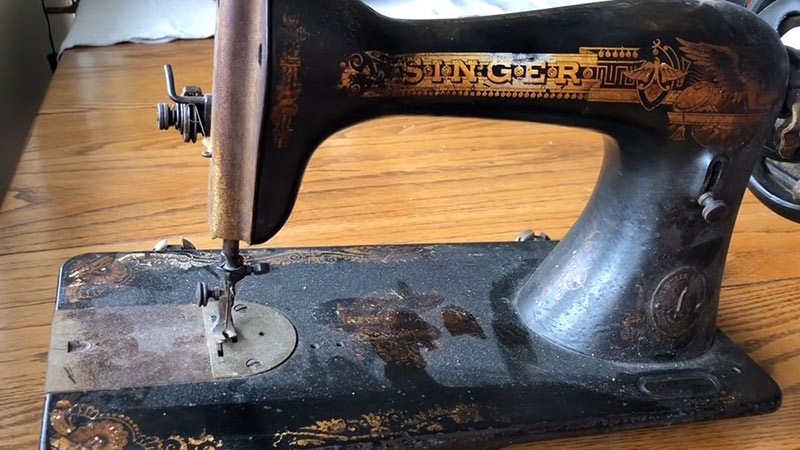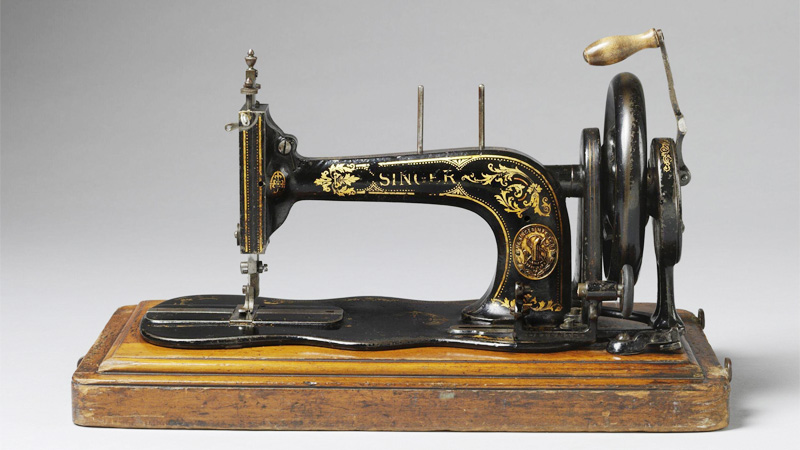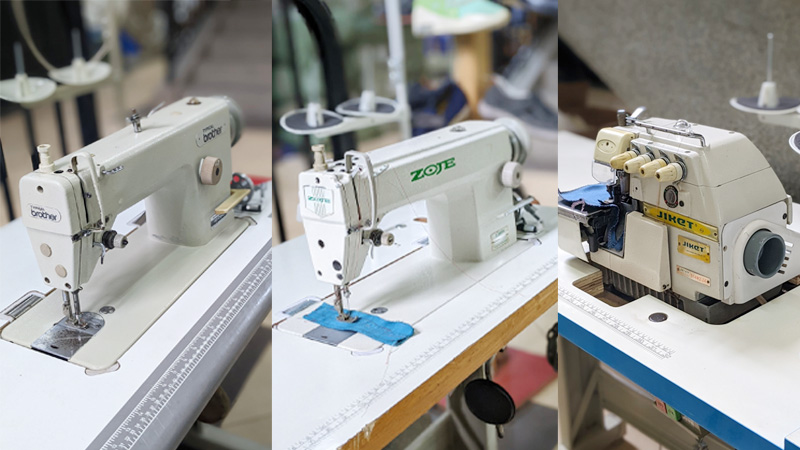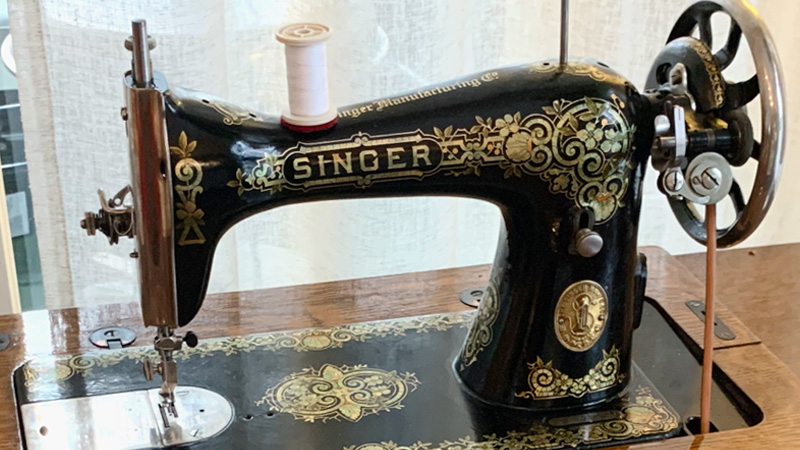Sewing machines have a rich history dating back to the 18th century, and they’ve played a crucial role in revolutionizing the textile and fashion industries.
One distinctive feature that often comes to mind when thinking about sewing machines, especially older models, is their cast iron components.
Cast iron was a prevalent material in the construction of vintage sewing machines, contributing to their durability and stability.
In this exploration, we delve into the fascinating world of sewing machine construction, examining the role of cast iron in shaping these iconic devices.
While cast iron was a staple in the past, we’ll also explore how modern sewing machines have evolved to incorporate a variety of materials, meeting the diverse needs of today’s sewers.

What Is a Cast Iron Sewing Machine?
A cast iron sewing machine refers to a type of sewing machine, typically vintage or older models, in which significant components of the machine’s structure are made from cast iron.
Cast iron is a heavy and durable material known for its stability and resistance to wear and tear. In cast iron sewing machines, elements like the machine frame, treadle stand, flywheel, bobbin winder, and various small parts are constructed from cast iron.
These components contribute to the machine’s stability, preventing vibrations during sewing and ensuring precise stitching.
While cast iron sewing machines were common in the past, modern machines utilize a variety of materials to achieve similar functionality with reduced weight and bulk.
Are Sewing Machines Cast Iron?
Sewing machines have evolved significantly over the years, and while some older models were indeed made with cast iron components, not all sewing machines are exclusively cast iron.
The use of cast iron in sewing machines primarily applies to vintage and older models, particularly those produced in the late 19th and early 20th centuries.
Cast iron was a popular choice for sewing machine construction during this period due to its durability and stability.
Sewing machines needed to be heavy and stable to ensure smooth and accurate stitching. Cast iron offered these qualities while also providing resistance to wear and tear.
Here are some key components of older sewing machines that were often made from cast iron:
Machine Frame
The base and body of many vintage sewing machines were typically constructed from cast iron.
This provided the necessary weight and stability to prevent vibrations during sewing, resulting in more precise stitches.
Treadle Stand
Many older sewing machines were operated using a treadle mechanism, which involved a foot pedal that moved a treadle wheel.
The stand supporting this treadle was often made from cast iron to provide stability and balance.
Flywheel
The flywheel on older sewing machines, which helped control the stitching speed and tension, was often made from cast iron.
Bobbin Winder
Some older sewing machines had cast iron bobbin winders, which were used to wind thread onto the bobbins.
Parts and Attachments
Various small components and attachments of vintage sewing machines, such as presser feet and shuttle assemblies, were also made from cast iron.
Advantages of a Cast Iron Sewing Machine

Cast iron sewing machines have several advantages, which is why they have been a popular choice among sewers, especially in the past.
Here are some of the advantages of a cast iron sewing machine:
Durability
Cast iron is known for its exceptional durability. Sewing machines with cast iron frames and components are built to last for many years.
They can withstand heavy use and are less prone to wear and tear compared to machines made from other materials.
Stability
Cast iron provides excellent stability and reduces vibrations during sewing. This stability is particularly important when working on intricate or detailed projects, as it helps maintain consistent stitch quality.
Reduced Noise
Cast iron’s weight and stability help dampen noise generated during sewing. This can create a quieter and more comfortable sewing environment, especially during long sewing sessions.
Less Vibration
Cast iron sewing machines are less likely to vibrate or wobble while sewing, ensuring smoother and more precise stitching. This is especially important for tasks that require fine details or delicate fabrics.
Longevity
Due to their robust construction, cast iron sewing machines tend to have a longer lifespan than machines made from other materials.
This can make them a cost-effective investment in the long run, as they require fewer repairs or replacements.
Vintage Appeal
Many sewists appreciate the vintage charm and aesthetic of cast iron sewing machines. They can add a touch of nostalgia and classic style to your sewing space.
Heavy-Duty Sewing
Cast iron sewing machines are well-suited for heavy-duty sewing tasks, such as working with thick fabrics, leather, or multiple layers of fabric. They can handle these materials with ease.
Steady Stitching
The weight and stability of cast iron help maintain a steady and even stitch, resulting in professional-looking sewing projects.
Collectibility
Vintage cast iron sewing machines are often considered collectible items. Some collectors value these machines for their historical significance and craftsmanship.
Types of Sewing Machines

Sewing machines come in various types, each designed to cater to specific sewing needs and skill levels.
Here are some of the most common types of sewing machines:
Mechanical Sewing Machines
These are basic, manual machines operated by hand and controlled using dials and knobs. They are suitable for beginners and simple sewing tasks like mending and basic garment construction.
Electronic Sewing Machines
Electronic sewing machines offer more features and automation. They have digital displays, push-button controls, and a range of stitches. These machines are versatile and suitable for a wide range of sewing projects.
Computerized Sewing Machines
These are highly advanced machines with built-in computer technology. They offer a vast selection of stitches and embroidery patterns.
Computerized machines allow for precise control and customization of stitches, making them suitable for quilting, embroidery, and intricate sewing projects.
Embroidery Machines
Specifically designed for embroidery work, these machines can create intricate designs and patterns on fabric. They often have larger embroidery hoops, and computerized controls, and may come with built-in design libraries.
Serger or Overlock Machines
Sergers are specialized machines for finishing the edges of the fabric and creating strong, neat seams. They trim excess fabric while stitching, preventing fraying.
They are commonly used in garment construction and sewing projects that require professional-quality seams.
Quilting Machines
Quilting machines are designed for quilting projects and have features like a wide throat space, extension tables, and walking feet to handle bulky layers of fabric easily.
Industrial Sewing Machines
These heavy-duty machines are built for high-speed, continuous sewing in industries such as clothing manufacturing, upholstery, and leatherwork. They are robust and capable of handling thick fabrics and heavy materials.
Mini Sewing Machines
Compact and portable, mini sewing machines are perfect for on-the-go or small sewing tasks. They are lightweight and easy to store, making them ideal for beginners or those with limited space.
Handheld Sewing Machines
These are small, battery-operated, or manually operated devices designed for quick repairs and minor sewing tasks. They are convenient for small, immediate fixes but not suitable for larger projects.
Multi-Needle Embroidery Machines
Professional embroidery machines with multiple needles allow for faster and more efficient embroidery work, as they can thread multiple colors simultaneously.
Heavy-Duty Sewing Machines
These machines are built for durability and can handle thick fabrics like denim and canvas. They are often used for projects like upholstery, making bags, or sewing leather.
Long Arm Quilting Machines
These specialized quilting machines have an extended throat space, making it easier to work on large quilting projects. They provide greater maneuverability and control.
Singer Sewing Machines Vintage

Singer sewing machines hold a special place in the world of vintage sewing machines due to their rich history and enduring popularity.
Here’s a brief overview of vintage Singer sewing machines:
Early Singer Models
The Singer Sewing Machine Company was founded in 1851 by Isaac Merritt Singer.
Some of the earliest Singer sewing machines, such as the Singer Model 1 and Model 2, were hand-cranked and featured ornate cast iron bases. These machines are highly sought after by collectors.
Treadle Singer Machines
In the late 19th and early 20th centuries, Singer produced treadle-operated sewing machines. These models, like the Singer Model 66 and Model 15, featured beautifully designed cabinets and were popular in households for generations.
Featherweight Series
Singer’s Featherweight series, introduced in 1933 with the Singer 221 and later the Singer 222, is one of the most iconic vintage sewing machine lines.
These compact, portable machines are known for their lightweight design, and reliability, and are still cherished by quilters and sewers today.
Art Deco Designs
In the 1930s and 1940s, Singer produced machines with stunning Art Deco designs, such as the Singer 201 and 301. These machines are prized for their aesthetics and sewing capabilities.
Slant-O-Matic Series
In the 1950s and 1960s, Singer introduced the Slant-O-Matic series, featuring machines like the Singer 401 and Singer 500.
These machines had a unique slant needle design for improved visibility and sewing performance.
Buttonholers and Attachments
Singer offered a wide range of attachments and accessories for their vintage machines, including buttonholers, rufflers, and embroidery attachments, which added to the versatility of their machines.
Limited Editions
Singer released limited edition and commemorative models over the years, adding to the allure of collecting vintage Singer sewing machines. These special editions often featured unique finishes and decorative touches.
Collectibility
Vintage Singer sewing machines are highly collectible, and enthusiasts often seek out these machines for their historical value, craftsmanship, and usability. Restored and well-maintained Singer machines can still be used for sewing today.
Online Communities
There are thriving online communities of vintage sewing machine collectors and enthusiasts who share information, restoration tips, and stories about their cherished Singer machines.
FAQS
What is a Seamstress Rotary Sewing Machine?
A Seamstress Rotary Sewing Machine is likely a type of sewing machine that uses a rotary hook mechanism for stitching.
How does a Seamstress Rotary Sewing Machine differ from other sewing machines?
The key difference is in the stitching mechanism. Seamstress Rotary Sewing Machines use a rotary hook, which can provide smoother and
Are all sewing machines made of cast iron?
No, not all sewing machines are made of cast iron.
While older, vintage sewing machines often feature cast iron frames, modern sewing machines come in a variety of materials, including aluminum, plastic, and steel.
Why were some sewing machines constructed with cast iron frames?
Sewing machines from the late 19th and early 20th centuries were often made with cast iron frames because cast iron is known for its durability and stability.
It provided a solid base for the machine’s components, reducing vibration during sewing.
Wrap Up
While not all sewing machines are cast iron, these sturdy, time-tested machines offer distinct advantages.
Cast iron sewing machines are celebrated for their exceptional durability, stability, and reduced vibration, making them ideal for heavy-duty sewing tasks and intricate projects. Their long lifespan and vintage charm add to their appeal.
However, it’s essential to recognize that modern sewing machines, crafted from various materials, have also made significant advancements in terms of durability and versatility.
The choice between cast iron and other materials ultimately depends on individual preferences, sewing needs, and the balance between tradition and modernity in the world of sewing.
Leave a Reply